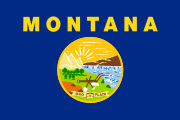
The following outline is provided as an overview of and topical guide to the U.S. state of Montana:
Contents
- General reference
- Geography of Montana
- Places in Montana
- Environment of Montana
- Regions of Montana
- Demography of Montana
- Government and politics of Montana
- Branches of the government of Montana
- Law and order in Montana
- Military in Montana
- History of Montana
- History of Montana, by period
- History of Montana, by region
- History of Montana, by subject
- History publications about Montana
- Culture of Montana
- The Arts in Montana
- Sports in Montana
- Economy and infrastructure of Montana
- Education in Montana
- See also
- References
- External links
Montana – fourth most extensive of the 50 states of the United States of America. Montana is the northernmost of the western Mountain States. The Territory of Montana joined the Union as the 41st state on November 8, 1889.



